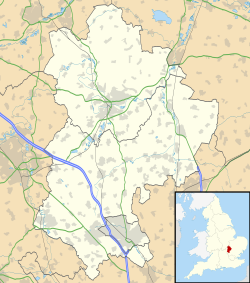History
The Icknield Way, a Roman road, passes through Limbury. Local road names give away its location: the road is called as 'Icknield Road' as it enters Limbury from Leagrave, then eventually the road continues on as Icknield Way.
In the thirteenth century, Limbury lay in Flitt Hundred, which was under the control of the manor of Luton. [4] : 32
The villages of Limbury and Leagrave were formed into the ecclesiastical parish of Holy Trinity, Biscot, in 1866. On 1 April 1896, under the provisions of the Local Government Act 1894, they became separate civil parishes from Luton Rural, Limbury and Biscot becoming the parish of Limbury-cum-Biscot.
At the end of the nineteenth century, Limbury was a small hamlet approximately two miles from Luton, near Leagrave village. At that time it consisted of just a few cottages and just two farms.
Moated houses still existed in around Limbury at the beginning of the 20th century. The Moat House (which was originally just outside Limbury, and is now part of the neighbouring suburb of Saints) is the only one remaining (now a pub/restaurant [5] ). It is reputed to be the oldest secular building in South Bedfordshire. In 2007 the Moat House had the roof rethatched. [6] [7]
In the early part of the 20th century, Luton was rapidly changing from a hat manufacturing town to one relying mainly on engineering. New factories were being built in the town as well as the existing ones expanding, mainly in the motor industry (Vauxhall moved to Luton in 1905). This meant more workers were needed, many of whom were housed in Limbury. Hedges and the rural landscape fast disappeared in Limbury as new housing developments replaced them.
With the increased number of workers a new Baptist church was built in 1906. It was built by Arthur Cole, who had signed a contract the previous August 1905 with the church that included the line, 'I... agree to build a chapel (at Limbury)... and (it) shall be finished in every particular so that the opening services may be held on Good Friday, 1906.' [8]
In 1921 the parish had a population of 1534. [9] On 1 October 1928, the civil parish was abolished, with the urbanised area being annexed to Luton, and the remaining part being split three-ways between Stopsley, Streatley and Sundon parishes. [10]
Further expansion of Limbury came in the 1950s when it expanded north of the River Lea, building on fields known as “Limbury Mead”, a term which is still used locally to refer to north Limbury.
Local area
At the centre of the original village of Limbury are Limbury Baptist Church, a small parade of shops on Neville Road, and The Black Swan pub on Black Swan Lane. On Gardenia Avenue is St. Joseph's Roman Catholic Church, built in the 20th century to serve Limbury's growing Irish Catholic population, as well as the neighbouring St. Joseph's R.C. Primary School (until 2014 two separate schools, an infants and a juniors school). There are two other schools in the area, Norton Road Primary School and The Meads Primary School.
The main shopping area is now centred on Limbury Mead Square at the junction of Watermead Road and Calverton Road.
There are large open spaces in Limbury following the path of the River Lea. [11]
This page is based on this
Wikipedia article Text is available under the
CC BY-SA 4.0 license; additional terms may apply.
Images, videos and audio are available under their respective licenses.


